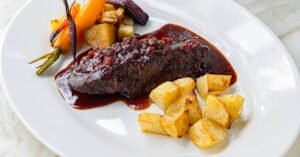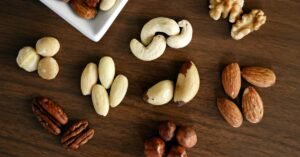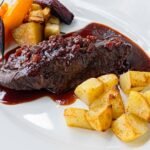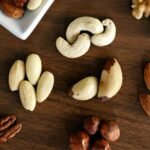As dog owners, we’re always curious about what human foods we can safely share with our furry friends. One common question that pops up is, ‘Can dogs eat bread?’ It’s a staple in many households, and those pleading puppy eyes can make it hard to resist tossing a piece their way. In this text, we’ll dive deep into whether bread is safe for dogs, exploring its nutritional value, potential risks, and how to incorporate it responsibly into your dog’s diet. We’ll also look at healthier alternatives to keep your pup happy and healthy. By the end, you’ll have a clear understanding of this topic, helping you make informed decisions for your canine companion.
Key Takeaways
- Dogs can eat plain bread in small amounts as it’s not toxic, but it offers minimal nutritional benefits like empty calories and carbs.
- Avoid breads with harmful additives such as garlic, onions, raisins, or chocolate, as they can cause serious health issues in dogs.
- Feeding bread to dogs may lead to digestive problems, allergies, or obesity if given excessively or to sensitive pets.
- Safely offer bread by limiting portions to less than 10% of daily calories and monitoring for any adverse reactions.
- Choose healthier alternatives like apples, carrots, or dog-specific treats over bread for better nutrition and safety.
Is Bread Safe for Dogs?
When we ask ourselves, ‘Can dogs eat bread?’ the short answer is yes, but with some important caveats. Bread isn’t toxic to dogs in small amounts, but not all types are created equal. We need to consider the ingredients and how it’s prepared to ensure it’s safe for our pets.You can learn how-to-stop-a-dog-from-digging
Plain Bread Options
Plain bread, like white or whole wheat without any added sugars, salts, or fats, is generally the safest option. We recommend sticking to simple varieties that don’t contain harmful additives. For instance, a small piece of plain toast can be a harmless treat. But, bread is mostly empty calories for dogs, offering little nutritional benefit compared to their regular diet. If you’re wondering about specific types, sourdough or rye bread might be okay in moderation, but always check for any unusual ingredients that could upset your dog’s stomach.You can learn how-to-make-your-dog-throw-up
Breads with Additives or Toppings
This is where things get tricky. Breads loaded with garlic, onions, raisins, or nuts, like garlic bread or raisin toast, are a big no-no. These ingredients can be toxic to dogs, leading to serious health issues such as anemia or kidney damage. We strongly advise against sharing baked goods with chocolate, xylitol (a common sweetener), or excessive butter, as they pose significant risks. If your dog sneaks a piece of something like banana bread, monitor them closely and consult a vet if symptoms arise. Remember, what seems like a tasty snack to us could be dangerous for our four-legged friends.
Nutritional Aspects of Bread for Dogs
Bread is primarily made from grains, which can provide some carbohydrates, but it’s not a powerhouse of nutrition for dogs. We see it more as an occasional filler rather than a dietary staple. Understanding its components helps us decide if and when to offer it.
Potential Benefits
On the positive side, bread can offer a quick energy boost from its carbs, which might be useful for active dogs. Whole grain breads provide a bit of fiber, aiding digestion in small doses. Some breads fortified with vitamins could sneak in minor nutrients, but honestly, these benefits are minimal compared to a balanced dog food. We’ve noticed that for dogs with sensitive stomachs, a plain piece of bread can sometimes settle mild nausea, acting like a bland diet component. But, we wouldn’t rely on bread for any substantial health perks, it’s more of a neutral treat than a superfood.You can learn how-to-introduce-a-cat-to-a-dog
Potential Risks and Health Concerns
While bread isn’t inherently harmful, there are several risks we should be aware of when considering if dogs can eat bread. Overindulgence or the wrong type can lead to problems, so moderation is key.
Digestive Issues
Bread is high in carbs and can cause bloating, gas, or constipation if given in large amounts. Dogs don’t process grains as efficiently as we do, and yeasted breads might ferment in their gut, leading to discomfort. We’ve heard from many pet owners whose dogs experienced diarrhea after eating too much bread. Also, moldy bread is a definite hazard, as it can contain mycotoxins that cause tremors or seizures.
Allergies and Sensitivities
Some dogs are allergic to wheat or gluten, common in many breads. Symptoms might include itching, ear infections, or gastrointestinal upset. If your dog shows signs of sensitivity after eating bread, it’s best to avoid it altogether. We recommend watching for reactions and consulting a vet for allergy testing if needed. Obesity is another concern: bread’s calories add up quickly, contributing to weight gain in less active dogs.You can learn how-to-draw-dog-man
How to Feed Bread to Dogs Safely
If you’ve decided that a bit of bread fits into your dog’s treat rotation, we have some tips to do it safely. The goal is to minimize risks while keeping things enjoyable.
Portion Guidelines
Start small, a piece no larger than a quarter of a slice for small dogs, and up to a full slice for larger breeds, but only occasionally. We suggest treating bread as less than 10% of your dog’s daily caloric intake to avoid nutritional imbalances. Always opt for fresh, plain bread and break it into small pieces to prevent choking. Monitor your dog after feeding to ensure no adverse reactions, and never use bread as a meal replacement.
Alternatives to Bread for Dog Treats
If bread seems risky or not ideal, there are plenty of better options out there. We love recommending treats that offer more nutritional value without the potential downsides.
Consider fruits like apples or blueberries, which provide vitamins and antioxidants. Veggies such as carrots or green beans make crunchy, low-calorie snacks. For something closer to bread, try homemade dog biscuits using dog-safe ingredients like peanut butter and oats. Commercial treats formulated for dogs ensure safety and balance. We’ve found that these alternatives not only satisfy cravings but also contribute to overall health, making them a smarter choice over regular bread.You can learn how-to-boil-chicken-for-dogs
Conclusion
In wrapping up, we’ve explored the ins and outs of whether dogs can eat bread. It’s generally safe in small, plain amounts, but the risks often outweigh the minimal benefits. We encourage you to prioritize your dog’s health by choosing nutritious alternatives and consulting with a veterinarian for personalized advice. By being informed, we can keep our pets safe and happy, after all, that’s what being a responsible dog owner is all about.
Frequently Asked Questions
Can dogs eat bread safely?
Yes, dogs can eat bread in small amounts, but it’s not toxic only if it’s plain varieties like white or whole wheat without additives. However, bread offers little nutritional value and should be an occasional treat. Avoid breads with garlic, onions, raisins, or chocolate, which can be harmful.
What types of bread should dogs avoid?
Dogs should avoid breads with toxic ingredients like garlic, onions, raisins, nuts, chocolate, or xylitol, such as garlic bread or raisin toast. These can cause serious issues like anemia or kidney damage. Stick to plain bread without added sugars, salts, or fats to minimize risks.
What are the potential risks of feeding bread to dogs?
Feeding bread to dogs can lead to digestive issues like bloating, gas, or diarrhea, especially in large amounts. Some dogs may have wheat or gluten allergies causing itching or upset stomachs. Additionally, bread’s high calories can contribute to obesity, and moldy bread may cause seizures.
How much bread can I give my dog?
Offer bread sparingly—start with a small piece, like a quarter slice for small dogs or up to one slice for larger breeds, and limit it to less than 10% of daily calories. Always use fresh, plain bread, break it into small pieces to avoid choking, and monitor for reactions.
Can dogs eat bread if they have diabetes?
Dogs with diabetes should avoid bread due to its high carbohydrate content, which can spike blood sugar levels. Opt for low-carb treats instead, and consult a vet for diet advice. While plain bread isn’t toxic, it’s not ideal for managing diabetes and could worsen the condition if overfed.
Are there nutritional benefits to giving dogs bread?
Bread provides some carbohydrates for quick energy and minor fiber from whole grains, which might aid digestion in small amounts. However, it’s mostly empty calories with minimal vitamins compared to balanced dog food. For dogs with mild nausea, plain bread can help settle stomachs, but it’s not a nutritional staple.

















